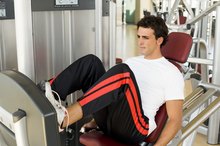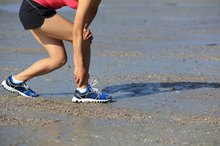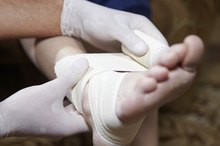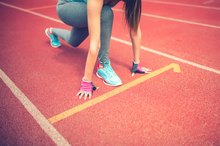What to Do for a Sore Calf From Hiking
Hiking can provide a relaxing outdoor experience, but if you overdo it, you may experience soreness. A sore calf from hiking could result from trying to do too much, too quickly. The soreness is usually a sign of your body adjusting to the new activity. However, you may have pulled your calf muscle or injured your Achilles tendon. If the pain persists, see your doctor.
Soreness, Sprains and Strains
During a hike, you'll know soon enough if your calves are up to the task. Walking uphill or on uneven ground can produce an ache in your calves that a rest stop and massage could very well cure. In addition, the lactic acid build-up and micro-tears that result from overworked muscles may be causing soreness. A sore calf could also indicate a sprain or a strain. Sprains usually result from a fall or accident and are caused by torn or pulled ligaments. Strains occur when you injure a muscle or tendon by over-stretching or overusing it. The symptoms of both sprains and strains include pain, swelling and bruising at the affected area. It is possible to have a sprain and a strain simultaneously. This occurs when an ankle sprain causes strain on the Achilles tendon, the tendon that connects the calf muscles to the back of the heel.
- During a hike, you'll know soon enough if your calves are up to the task.
- Walking uphill or on uneven ground can produce an ache in your calves that a rest stop and massage could very well cure.
Shin Splints
Exercise Plans for the Extremely Out of Shape
Learn More
Overexertion from hiking can cause shin splints, which result in mild to severe aches in the front of your lower leg. Stretching before a hike and wearing arch supports in your hiking boots may help prevent or relieve shin splints. Apply ice for 15 minutes after exercise if the pain persists. If it continues to hurt when you walk, you may have a slight fracture of your tibia. Take a break from exercising for two weeks and see your doctor if the pain persists.
- Overexertion from hiking can cause shin splints, which result in mild to severe aches in the front of your lower leg.
- Stretching before a hike and wearing arch supports in your hiking boots may help prevent or relieve shin splints.
Prevention
If you're a beginning hiker or someone who hikes only occasionally, start with easy adventures and work your way up to more difficult ones. Warm up and stretch the back of your legs before hiking, by bending forward without bouncing or straining for up to one minute. Wear hiking boots that fit your feet, and replace them when they become worn out. If you feel pain during a hike, slow down or take a break. After a hike, stretch your muscles to cool down. To strengthen your calves and prevent future soreness, exercise by standing on your toes for 10 seconds, coming down flat on the floor, and then repeating the movement 20 times.
- If you're a beginning hiker or someone who hikes only occasionally, start with easy adventures and work your way up to more difficult ones.
- If you feel pain during a hike, slow down or take a break.
Treatment
Pain in the Quadriceps
Learn More
For a strain or sprain, use the RICE technique: rest, ice, compression and elevation. Rest for one to two days after the exercise while icing the affected area for 10 minutes every two hours. Place a snug elastic bandage on the injury, removing it for 15 to 20 minutes every three to four hours. Raise the injury above the level of your heart. Liniments, balms and over-the-counter medications may relieve the pain. For mild soreness, cease all activities that could make the pain worse.
- For a strain or sprain, use the RICE technique: rest, ice, compression and elevation.
- Place a snug elastic bandage on the injury, removing it for 15 to 20 minutes every three to four hours.
Related Articles
References
- U.S. Department of Veterans Affairs: Prevention Tips for Sore Muscles or Cramps
- Chinn L, Hertel J. Rehabilitation of ankle and foot injuries in athletes. Clin Sports Med. 2010;29(1):157–167. doi:10.1016/j.csm.2009.09.006
- Knee ligament sprains and tears: Clinical practice guidelines-ensuring best care. J Orthop Sports Phys Ther. 2017;47(11):824. doi:10.2519/jospt.2017.0511
- American Academy of Orthopaedic Surgeons. Wrist sprains. Updated April 2018.
- National Institutes of Health. National Institute of Arthritis and Musculoskeletal and Skin Disease. Sprains and strains. Updated January 2015.
- Wolfe MW, Uhl TL, Mattacola CG, McCluskey LC. Management of ankle sprains. Am Fam Physician. 2001;63(1):93–104.
- Fernandes TL, Pedrinelli A, Hernandez AJ. Muscle injury - physiopathology, diagnosis, treatment and clinical presentation. Rev Bras Ortop. 2015;46(3):247–255. doi:10.1016/S2255-4971(15)30190-7
- Ernlund L, Vieira LA. Hamstring injuries: update article. Rev Bras Ortop. 2017;52(4):373–382. doi:10.1016/j.rboe.2017.05.005
- Federer AE, Steele JR, Dekker TJ, Liles JL, Adams SB. Tendonitis and tendinopathy: What are they and how do they evolve?. Foot Ankle Clin. 2017;22(4):665–676. doi:10.1016/j.fcl.2017.07.002
- Field LD, Savoie FH. Common elbow injuries in sport. Sports Med. 1998;26:193–205 doi:10.2165/00007256-199826030-00005
- Grassi A, Quaglia A, Canata GL, Zaffagnini S. An update on the grading of muscle injuries: a narrative review from clinical to comprehensive systems. Joints. 2016;4(1):39–46. doi:10.11138/jts/2016.4.1.039
- Erickson LN, Sherry MA. Rehabilitation and return to sport after hamstring strain injury. J Sport Health Sci. 2017;6(3):262–270. doi:10.1016/j.jshs.2017.04.001
- Harvard Health Publishing. Recovering from an ankle sprain. Updated April 2019.
- Porter T, Rushton A. The efficacy of exercise in preventing injury in adult male football: a systematic review of randomised controlled trials. Sports Med Open. 2015;1(1):4. doi:10.1186/s40798-014-0004-6
- Blanchard S, Palestri J, Guer JL, Behr M. Current soccer footwear, its role in injuries and potential for improvement. Sports Med Int Open. 2018;2(2):E52–E61. doi:10.1055/a-0608-4229
- Woods K, Bishop P, Jones E. Warm-up and stretching in the prevention of muscular injury. Sports Med. 2007;37(12):1089–1099. doi:10.2165/00007256-200737120-00006
- American Academy of Orthopaedic Surgeons. Sprains, Strains and Other Soft-Tissue Injuries.
Writer Bio
Jen Morel has worked in the newspaper industry since 2007. An experienced backpacker, she is a contributor to "AMC Outdoors" and other hiking/environmental magazines. She holds a Bachelor of Arts in cognitive science and philosophy.








